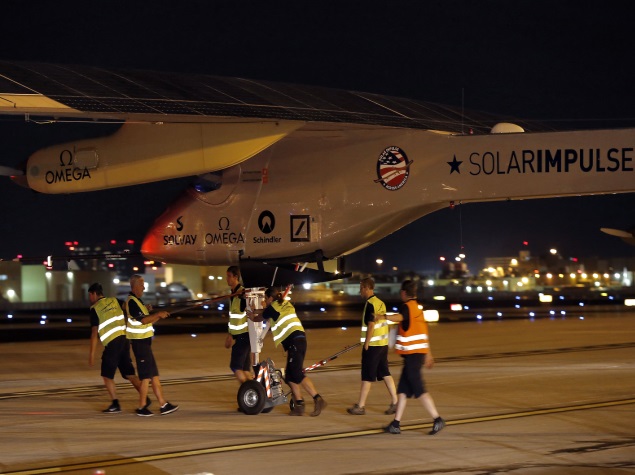
Solar Impulse 2 will be stuck in Japan for at least a week, its pilot has said, after sustaining damage to its delicate wing while on the ground.
The plane was en route from China to Hawaii, in the most ambitious leg of a record-breaking attempt to circumnavigate the globe using only the power of the sun.
But mission controllers ordered it to divert to Nagoya on Monday, because a burgeoning cold front over the Pacific was blocking its path to the US islands.
Gusts of wind have since damaged the left aileron the moving hinge on the trailing edge of the wing that controls the plane’s roll.
“It will take about one week for us to repair this small damage,” pilot Andre Borschberg told reporters in Nagoya late Wednesday.
“It will take a week in fact to bring some materials from Switzerland and to make the repair, then we should be ready in fact to continue and hopefully to reach Hawaii”, he said.
In footage posted on the project’s website, mission initiator Bertrand Piccard said exposure to the elements had been the problem.
“Before the team at Nagoya airport could inflate the mobile hangar, the wing had to be protected with a cover for the rain and the sun,” he said.
“There were so much wind and gusts that this cover started to shake on the wing and damaged an aileron on the trailing edge of the wing.
“This of course will be repaired, the technical team already started to build some spare parts but it will keep us on the ground for at least one week before we can carry on and André to fly to Hawaii.”
Borschberg said Wednesday the team would be watching the weather, with Japan’s month-long rainy season already under way in the south of the country, and expected to advance northwards over the coming days.
“In between (rainy days) there will be also sunny spots”, he told AFP, adding the team will choose a break in the weather to leave and may fly further north to reach Hawaii.
The fuel-free aircraft can be more flexible than a conventional plane as long as it gets sunlight, he said.
“The challenge and the goal is to get sun every morning,” he said.
‘Right mindset’
Once the team gives the green light for Borschberg to fly out of Nagoya, he will set his course for Hawaii, a journey that is expected to take five days.
If successful, that will smash the 44-hour continuous flight record for such a plane he set from Nanjing, China.
The 62-year-old Swiss said he practises yoga during his long solo stretches in the cockpit and tries to maintain the “right mindset”.
“I train special postures, which I do every day in the cockpit… to keep the right mental attitude,” he told AFP.
“Breathing can help… yoga is much about breathing.”
But he admitted that being cooped up in the 3.8 cubic metre (130 cubic foot) cockpit for long stretches of time was a challenge.
He said he would “sleep 20 minutes at a time, normally at night of course over the ocean. But it’s not sufficient.
“And to eat we have special food we can keep in temperatures in the cockpit varying from minus 20 (celsius, -4 Fahrenheit) when we are very high to plus 30 when we are very low.
“And of course (the) toilet which is integrated to the seat which I used successfully (for) two days.
“It’s like a home, you build a home and the goal is really to feel at home to be able mentally to accept and like… this cockpit.”
After Hawaii, Solar Impulse, a bid to raise awareness of the possibilities of renewable energy, is scheduled to head towards the US mainland before crossing the Atlantic on its way back to its Abu Dhabi starting point.
[“Source-gadgets.ndtv.com”]







